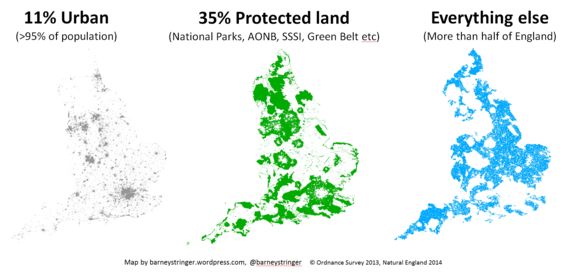The big planning question is whether towns and cities should have more space to grow. How should we balance a growing population and protecting the countryside? These maps show how England currently strikes that balance.
A recent UK NEA study found that less than 2.3% of England is actually built on. When you add in the natural or open areas that go along with development - the parks, allotments, playing fields, reservoirs and gardens - you get nearly 11% of the country that is "irreversibly urban in character" (ONS definition here).

That's what the first of the three maps shows. The extent of England's cities, towns, industrial estates and villages, which are the home of more than 95% of the population.
This 11% of land has taken centuries to urbanise, but in the last few decades the big growth has been in land protected from development. As the centre map shows a huge proportion of the country, roughly 35%, is now designated with one statutory protection or another. For every hectare of built-up land in England we have now protected three hectares of countryside.
This doesn't really fit with the image of a once green and pleasant land becoming increasingly crowded as development relentlessly eats away at the countryside. The reality is England feels crowded because we all crowd into such small corners of it.
In this map I've combined some of the main statutory protections:
- National Parks
- Areas of Outstanding Natural Beauty (AONB)
- Sites of Special Scientific Interest (SSSI)
- Ramsar Convention sites
- Special Protection Areas
- Special Areas of Conservation
- National and Local Nature Reserves
- Green Belts
These are all strong designations which largely prevent significant housing growth on undeveloped land. In addition to the major areas shown on the map, there are many more small areas where development is also rightly restricted, including ancient woodland, country parks, and land owned by the Woodland Trust, RSPB, English Heritage and the National Trust.
So what is left? The final map, on the right, shows what might be called "ordinary" countryside, which accounts for more than half of England. This land is nearly empty of residents (it excludes the built-up areas where more than 95% of us live). It is mostly agricultural, a working landscape but supporting very few jobs. Well under 1% of us work in agriculture, and the sector accounts for only half a percent of the economy.
This half of England is not developed, but nor is it of sufficient scenic or wildlife virtue to have statutory protection. It ranges from the beautiful to the dreary, and England would be much the poorer were we to lose it all. However we will also be much poorer if we don't allow ourselves a little bit more of it to live on.